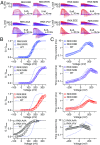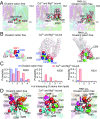Large-conductance Ca2+- and voltage-gated K+ channels form and break interactions with membrane lipids during each gating cycle
- PMID: 30967508
- PMCID: PMC6486743
- DOI: 10.1073/pnas.1901381116
Large-conductance Ca2+- and voltage-gated K+ channels form and break interactions with membrane lipids during each gating cycle
Abstract
Membrane depolarization and intracellular Ca2+ promote activation of the large-conductance Ca2+- and voltage-gated (Slo1) big potassium (BK) channel. We examined the physical interactions that stabilize the closed and open conformations of the ion conduction gate of the human Slo1 channel using electrophysiological and computational approaches. The results show that the closed conformation is stabilized by intersubunit ion-ion interactions involving negative residues (E321 and E324) and positive residues (329RKK331) at the cytoplasmic ends of the transmembrane S6 segments ("RKK ring"). When the channel gate is open, the RKK ring is broken and the positive residues instead make electrostatic interactions with nearby membrane lipid oxygen atoms. E321 and E324 are stabilized by water. When the 329RKK331 residues are mutated to hydrophobic amino acids, these residues form even stronger hydrophobic interactions with the lipid tails to promote the open conformation, shifting the voltage dependence of activation to the negative direction by up to 400 mV and stabilizing the selectivity filter region. Thus, the RKK segment forms electrostatic interactions with oxygen atoms from two sources, other amino acid residues (E321/E324), and membrane lipids, depending on the gate status. Each time the channel opens and closes, the aforementioned interactions are formed and broken. This lipid-dependent Slo1 gating may explain how amphipathic signaling molecules and pharmacologically active agents influence the channel activity, and a similar mechanism may be operative in other ion channels.
Keywords: BK; KCa1.1; Slo1; electrophysiology; molecular dynamics.
Conflict of interest statement
The authors declare no conflict of interest.
Figures





Similar articles
-
Properties of Slo1 K+ channels with and without the gating ring.Proc Natl Acad Sci U S A. 2013 Oct 8;110(41):16657-62. doi: 10.1073/pnas.1313433110. Epub 2013 Sep 25. Proc Natl Acad Sci U S A. 2013. PMID: 24067659 Free PMC article.
-
Molecular basis for differential modulation of BK channel voltage-dependent gating by auxiliary γ subunits.J Gen Physiol. 2015 Jun;145(6):543-54. doi: 10.1085/jgp.201511356. J Gen Physiol. 2015. PMID: 26009545 Free PMC article.
-
Modulation of BK channel gating by the ß2 subunit involves both membrane-spanning and cytoplasmic domains of Slo1.J Neurosci. 2010 Dec 1;30(48):16170-9. doi: 10.1523/JNEUROSCI.2323-10.2010. J Neurosci. 2010. PMID: 21123563 Free PMC article.
-
Transduction of voltage and Ca2+ signals by Slo1 BK channels.Physiology (Bethesda). 2013 May;28(3):172-89. doi: 10.1152/physiol.00055.2012. Physiology (Bethesda). 2013. PMID: 23636263 Free PMC article. Review.
-
Emerging issues of connexin channels: biophysics fills the gap.Q Rev Biophys. 2001 Aug;34(3):325-472. doi: 10.1017/s0033583501003705. Q Rev Biophys. 2001. PMID: 11838236 Review.
Cited by
-
Disruption of a side portal pathway permits closed-state inactivation by BK β subunit N termini.J Gen Physiol. 2025 Jul 7;157(4):e202513790. doi: 10.1085/jgp.202513790. Epub 2025 May 30. J Gen Physiol. 2025. PMID: 40445147
-
Aromatic interactions with membrane modulate human BK channel activation.Elife. 2020 Jun 29;9:e55571. doi: 10.7554/eLife.55571. Elife. 2020. PMID: 32597752 Free PMC article.
-
A PIP2 substitute mediates voltage sensor-pore coupling in KCNQ activation.Commun Biol. 2020 Jul 16;3(1):385. doi: 10.1038/s42003-020-1104-0. Commun Biol. 2020. PMID: 32678288 Free PMC article.
-
Multiple Targets for Oxysterols in Their Regulation of the Immune System.Cells. 2021 Aug 13;10(8):2078. doi: 10.3390/cells10082078. Cells. 2021. PMID: 34440846 Free PMC article. Review.
-
Lipid-mediated hydrophobic gating in the BK potassium channel.Nat Commun. 2025 Aug 9;16(1):7354. doi: 10.1038/s41467-025-61638-9. Nat Commun. 2025. PMID: 40783487 Free PMC article.
References
-
- Pantazis A, Olcese R. Biophysics of BK channel gating. Int Rev Neurobiol. 2016;128:1–49. - PubMed
Publication types
MeSH terms
Substances
Grants and funding
LinkOut - more resources
Full Text Sources
Miscellaneous

